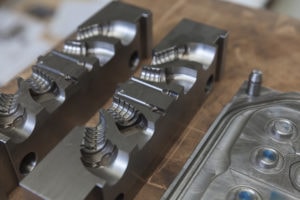Intro
When it comes to injection molding, the biggest expense is the upfront tooling costs. You might spend $100,000 on a complicated tool, but then it only costs $0.10 per part afterwards. In an effort to save money and time, a lot of people turn to MUD.
In this guide, we’ll explain what MUD is, how it saves you money, and some other benefits of this method.
A Quick Preface
Before we can get into Master Unit Dies (MUD), we should explain prototype and production tooling. As you’ll see, MUD is a sort of combination of the two concepts. We promise, you’ll learn about MUD in no time — just bear with us.
Metal tool for molding rubber products
Introduction to Injection Molding

MUD, prototyping, and production tooling are all a part of injection molding. Injection molding is a form of fabrication that makes plastic parts very quickly for incredibly low per-unit costs. It can be used to make hundreds of thousands of the same part each year.
An injection molding machine holds the mold, clamps them together, fills the cavity with liquid plastic, lets it cool, then opens the mold and lets the part drop out before repeating the process. Depending on the part, the full operation could just take a few seconds or minutes to make a production-grade part.
How Prototype Tooling Works
Prototype tooling is the perfect option if you’re looking for a low-volume batch of parts. These parts will be your functional prototypes, and you can do a lot with them.
Some of our customers use their prototypes to conduct tests, prove out a concept, or gain buy-in from stakeholders. Depending on the specifics, it might make sense to consider 3D printing or urethane casting instead.
With prototype tooling, an operator will hand-load each mold into the injection molding machine, then they’ll separate the mold by hand afterwards. This is the case because the tooling isn’t made to interface automatically with the injection molder. Skipping this step saves a lot of money and time upfront.
Plus, why would you want to waste money on a tool for a prototype before you have a production design finalized?
Defining Production Tooling
Once you finalize the design, then you’re ready for production tooling. This is a dedicated mold that is used specifically to make the part that you designed. If your part is smaller or simpler, the mold might have a few cavities in it.
This means that you can make multiple units at the same time (one in each cavity).
The key difference is that production tooling is set up to run at full speed. It will automatically be loaded, cooled, and retrieved from the injection molding machine. In a lot of cases, the machine will keep running with this tool until it hits your desired quantity for your order.
What Is MUD?
A Master Unit Die (MUD) is a hybrid version of production and prototype tooling. It’s a standardized way to run an injection molding machine that utilizes inserts and stock external parts that have been pre-built.
The custom inserts go into the standard base, then the tool is put through the injection molder.
The key here is that you’re only worrying about the insert. The base and external parts are already on-hand at the injection molding facility. The shop will simply make a custom insert for your part, then start molding.
The alternative is to make a production tool from scratch, which involves a lot more design, interfacing, and material. It also features full automation in the main base, so there’s no more hand-loading molds.
Benefits of MUD
Let’s discuss some of the main benefits of MUD. A lot of these points come from personal experience and customer feedback.
Lower Upfront Tooling Costs
As the title suggests, MUD is great at reducing upfront tooling costs. It all goes back to the simplicity and removal of material. Instead of making a massive dedicated mold, we’re just machining a small insert that slips into a pre-fabbed master mold.
Faster Changeovers
By changing the insert, the injection molding machine will start making a completely different product. This is much faster than changing the whole mold, allowing for faster changeovers from one product to another.
For us, that means that we can swap between production runs a lot faster and fulfill multiple orders even quicker. For you, it means less downtime and fewer manhours (therefore a lower cost) dedicated to preparing the injection molder.
Favorable Per-Unit Costs
MUD bases and inserts are very reliable and require little maintenance over time. Instead, we can focus on running the molding machine and continuing production.
As we mentioned earlier, MUD setups have a lower upfront tooling cost. Well, your per-unit costs will factor in any upfront costs plus a continued production cost. As a result, you’ll spend even less per unit as compared to production tooling runs, regardless of how many parts you make.
Faster Turnaround Times
In some injection molding cases, you might be waiting months for the mold to be fabricated. With MUD inserts, that time is shortened by weeks. You’ll get your first production units faster, and the overall turnaround time will be shortened by a lot.
Conclusion
We just explained some of the great perks of using a MUD in injection molding. It’s a great way to minimize your cost and turnaround time without sacrificing on the quality of the final parts.
If you want to learn more about injection molding or you want to get started on your own project today, reach out to our experts at Rapid Axis. We offer a wide range of injection molding services, and we can handle your full production run.
